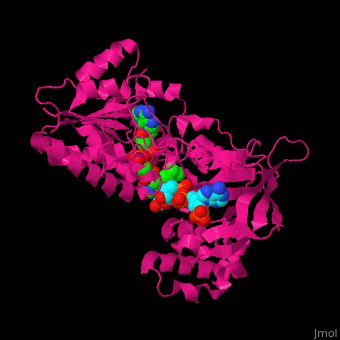Function
Adrenodoxin reductase (AR) is an FAD containing flavoprotein that functions as an electron transfer protein in the mitochondrial P450 systems that catalyze essential steps in the biosynthesis of steroid hormones.[1]
The enzyme nomenclature code of AR is 1.18.1.6.
Mitochondrial P450 systems
Mitochondrial P450 systems are expressed in cells that specialize in the biosynthesis and secretion of steroids. The reactions these systems catalyze include the first step in steroid hormone synthesis that is cleavage of the side chain of cholesterol producing pregnenolone, C11- hydroxylation of steroids producing glucocorticoids, C-18 hydroxylation of steroids leading to the synthesis of mineralocorticoids, and C-25 and C-27 hydroxylations of steroids in the pathways of bile acid and vitamin D synthesis.[1]
Mitochondrial P450 systems are composed of three proteins:
- Adrenodoxin reductase
- Adrenodoxin, a [2Fe-2S] ferredoxin type iron-sulfur protein
- Mitochondrial P450
The first two electron transfer proteins are shared by all systems. Substrate and reaction specificity of the system is dependent on the type of P450.
The reactions catalyzed by P450 type enzymes are called monooxygenation reactions because P450 catalyzes incorporation of only one atom of molecular O2 into substrate (S) while reducing the second atom of O into H2O with the following stoichiometry:
SH + O2 + NAD(P)H + H+ → ROH + H2O + NAD(P)+
In the mitochondrial P450 systems, the source of electrons is NADPH. The main function of AR in these systems is to accept two electrons from NADPH which are transferred to FAD with the following stoichiometry:
NADPH + H+ + FAD → NADP+ + FADH2
After this initial transfer, AR catalyzes transfer of electron from FADH2 to adrenodoxin in two independent steps as adrenodoxin is a single electron acceptor. Reduced adrenodoxin in turn transfers its electron to mitochondrial P450 during the complex catalytic cycle of P450.
Thus, the route of electron transfer in these systems is as follows:
NADPH → AR → adrenodoxin → P450
Structure of adrenodoxin reductase
AR has two main domains. The N terminal domain contains a Rossmann fold that binds FAD and a central domain that binds NADPH.[2]
The following scenes illustrate some aspects of the structure.
To rotate the molecule click and hold left mouse button.
To zoom-in or zoom-out first click on the structure and then use the mouse wheel.
Click the following green links for the action indicated:
(water molecules shown as red spheres)
(water molecules shown as red spheres) (PDB entry 1e1k)[3]
3D Structures of Adrenodoxin reductase
Adrenodoxin reductase 3D structures

